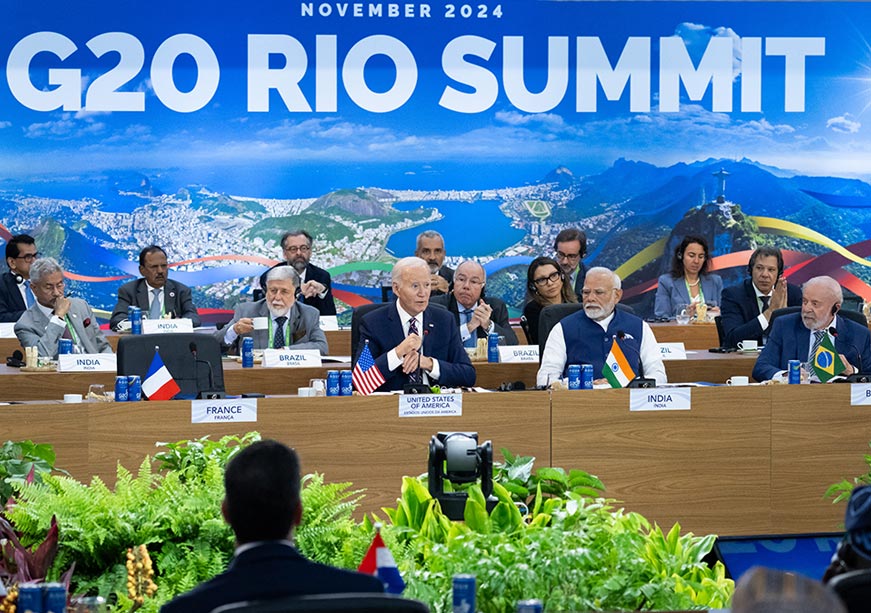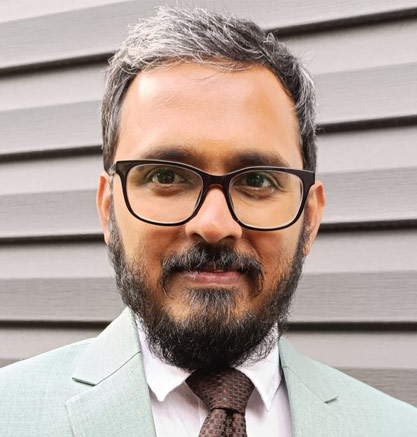-
CENTRES
Progammes & Centres
Location
Although global consensus at the recent G20 summit is limited, the event looks to strengthen India’s bilateral ties with Latin American nations

Image Source: Getty
Before taking over as the rotating chair of the G20 (Group of 20), Brazil’s president Luiz Inácio Lula da Silva likened the grouping’s annual summit to a diplomatic “World Cup”. Given the sheer size and influence of the group’s members, which make up some 85 percent of the global gross domestic product (GDO), the host of the annual G20 summit usually takes the limelight. The Brazilian presidency focused on three priorities, highlighted in the final declaration as “(i) social inclusion and the fight against hunger and poverty; (ii) sustainable development, energy transitions and climate action; and (iii) the reform of global governance institutions.”
Yet, this year’s G20 summit in Rio de Janeiro will be remembered as the backdrop to a metamorphosing global order, one where countries struggle to find consensus on the most urgent issues of our day, be it climate change, war or gender equality. The Summit took place under the shadow of the recently elected president of the United States, Donald Trump, who will likely overturn any consensus that the grouping arrives at, when he assumes power in January 2025. Some considered Argentina’s libertarian president Javier Milei as Trump’s stand-in at the summit, baulking at the G20 communique’s calls for “progressive taxation, gender equality and embrace of the United Nations' sustainable development goals.” Despite its outsized influence as a grouping of the world’s largest economies, the G20 has achieved little since they last came together in 2008-09 to address the global financial crisis. As one observer notes, the G20 is now a product of a bygone era of international politics, “where heads of state appear for photo opportunities while bureaucrats work furiously behind the scenes, dedicated to the proposition that the complex challenges that arise out of global economic interdependence can be solved, or at least ameliorated, if enough clever men and women put their minds to it.”
The Summit took place under the shadow of the recently elected president of the United States, Donald Trump, who will likely overturn any consensus that the grouping arrives at, when he assumes power in January 2025.
Although there was little global consensus at the G20 Summit, there was plenty of common ground between the host, Brazil, and the previous chair of the grouping, India. Modi’s remarks at the summit paid heed to Brazil’s priorities, echoing New Delhi’s common interests in renewable energy, eliminating poverty and hunger, and focusing on nutrition and food security. Modi took the opportunity to hold bilateral meetings with some of India’s most important partners in the Latin American region, including Argentina and Chile. While Modi’s meeting with Milei lays the groundwork for future ties, the bilateral meeting with Chile saw some progress in the expansion of the India-Chile Preferential Trade Agreement, which Chile’s president Gabriel Boric has now termed as a CEPA or a Comprehensive Economic Partnership Agreement. If the India-Chile trade agreement is indeed alleviated to the level of a CEPA—equivalent to the comprehensive agreements India has signed with the United Arab Emirates (UAE), South Korea or Japan—it would signal an important development in New Delhi’s priorities towards the Latin American region. For years, India’s trade agreements with Chile and Mercosur, a regional bloc that includes Brazil, Argentina, Uruguay and Paraguay, have been limited in scope, due in large part to New Delhi’s reluctance to sign free trade agreements.
Modi took the opportunity to extend his South American journey to Brazil’s northern neighbour, Guyana, in a two-day visit that also saw the second India-CARICOM Summit. CARICOM, short for the Caribbean Community, is a grouping of 15 Caribbean nations that displays an apt example of ‘small state diplomacy’. As is customary for small states, CARICOM uses its regional integration network to level the playing field when meeting with large countries. More importantly, CARICOM maintains regular dialogue with all major global actors; after all, the India-CARICOM summit comes on the heels of the fourth China-Caribbean Forum in September 2024. India’s deep cultural linkages with the Caribbean notwithstanding (the Caribbean is home to a large Indian-origin population), the economic linkages between India and the CARICOM countries remains at an incipient stage, with bilateral trade at US$814 million in 2023.
Guyana has skyrocketed to become the world’s fastest-growing economy and one of the world’s newest oil producers, even overtaking neighbouring Venezuela which is home to the largest oil reserves on the planet.
Perhaps more intriguing than the India-CARICOM Summit is Modi’s bilateral visit in Guyana, where he signed 10 agreements ranging from agriculture and defence to pharmaceuticals and financial payment systems. Yet, one single topic eclipses all others when it comes to Guyana: oil. Practically overnight, Guyana has skyrocketed to become the world’s fastest-growing economy and one of the world’s newest oil producers, even overtaking neighbouring Venezuela which is home to the largest oil reserves on the planet. Oil has been a topic of discussion between India and Guyana for many years now. Yet, so far, nothing has materialized. Despite multiple high-level visits between India and Guyana, Indian oil companies failed to submit any bids in Guyana’s public auctions for offshore oil blocks. India’s demand for large quantities of oil, which it seeks at some discount, has yet to find resonance in Georgetown, due in part to the fact that a large portion of Guyana’s oil production is managed by international oil majors like ExxonMobil. For now, New Delhi must be content with obtaining heavily discounted Russian oil and paying a fair price to producers in West Asia that can swiftly export crude oil as per India’s requirements.
Hari Seshasayee is a Visiting Fellow at the Observer Research Foundation and is a co-founder of Consilium Group.
The views expressed above belong to the author(s). ORF research and analyses now available on Telegram! Click here to access our curated content — blogs, longforms and interviews.

Hari Seshasayee is a visiting fellow at ORF, part of the Strategic Studies Programme, and is a co-founder of Consilium Group. He previously served as ...
Read More +